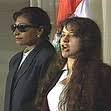





Lori Berenson
From Wikipedia, the free encyclopedia
| This biographical article needs additional citations for verification. Please help by addingreliable sources. Contentious material about living persons that is unsourced or poorly sourcedmust be removed immediately, especially if potentially libelous or harmful. (November 2007) (Find sources: Lori Berenson – news, books, scholar) |
| Lori Helene Berenson | |
|---|---|
| Born | November 13, 1969 New York, NY, U.S. |
| Charge(s) | collaboration with a terrorist organization (under Peruvian law) |
| Penalty | 20 years imprisonment |
| Status | serving sentence |
| Occupation | translator, secretary |
| Spouse | Aníbal Apari Sánchez |
| Parents | Rhoda Kobeloff Berenson and Mark Berenson |
Lori Helene Berenson (born November 13, 1969) is a U.S. citizen currently serving a 20-year prison term in Peru after being convicted of unlawful collaboration with a terrorist organization, specifically the Túpac Amaru Revolutionary Movement, an organization which had committed numerous attacks in attempting to overthrow the government of Peru. She has been imprisoned since 1995. However, she and her supporters maintain her innocence.
In Spanish-language news reports and her trial documents, because of Spanish naming customs, Berenson is often referred to as Lori Berenson Mejía or Lori Berenson Kobeloff.
Contents[hide] |
[edit]Background
Berenson was born in New York City to Mark Berenson and his wife Rhoda, both college professors. Berenson volunteered for soup kitchens and blood banks as a teenager. While an undergraduate at MIT, a course of study she did not complete, Berenson volunteered with theCommittee in Solidarity with the People of El Salvador (CISPES). Later, she went to El Salvador and became secretary and translator for Leonel González, a leader of the Farabundo Martí National Liberation Front (FMLN), during negotiations that achieved peace in 1992.[1] FMLN was at that time an umbrella organization associated with various leftist guerilla organizations and the Salvadoran Communist Party and working to overthrow the Salvadoran military dictatorship. FMLN transitioned during the peace process to a become a legitimate and legal political party.
After political reconciliation came to the area Berenson moved to Peru. During her travels and political activities, she was supported by an educational trust fund established by her parents.
[edit]Activities in Peru and arrest
| This section is missing citations or needs footnotes. Please help add inline citations to guard against copyright violations and factual inaccuracies. (January 2009) |
In Peru Berenson met members of the Túpac Amaru Revolutionary Movement (MRTA), a group that had committed numerous insurgent attacks in Peru including kidnapping, bank robberies, extortion, hostage taking, and assassinations. Berenson, however, denies knowing that they were MRTA members.
Berenson co-rented a large house in Lima in an upscale neighborhood. Much of the house was later used as a safe house by MRTA operatives, with up to 15 of them occupying their part of the residence.[2] Berenson later claimed to be unaware of the connection and to have moved out some months prior to her arrest.[2]
With no training or publication record as a journalist, she obtained press credentials for herself and her photographer to the Congress of Peru. Berenson represented that she was writing articles on the effect of poverty on women in Perú for two now defunct New York publications, Modern Times and Third World Viewpoint. Her photographer, Nancy Gilvonio, was actually the wife of Néstor Cerpa, the MRTA second-in-command — although Berenson claims she was unaware of this connection and claimed that she knew her only as a Bolivian photographer. Berenson had entered the main Congress building with Gilvonio several times during 1995 to interview members of Congress. Gilvonio provided the information she collected to the MRTA including detailed information on the floor plans of Congress, its security and members. The plan was for the MRTA to invade the Congress building, kidnap the legislators, and exchange the hostages for MRTA prisoners.
On November 30, 1995, Berenson and Gilvonio were arrested on a public bus in downtown Lima. Berenson was accused of being a leader of the MRTA, which had been officially classified as a terrorist group by the government. Berenson was seized from a public bus hours before an all-night siege of the MRTA safe house which had been co-rented by Berenson, in which three MRTA guerrillas and one police officer died and 14 guerrillas were captured. The safe house was found to contain an "arsenal of weapons",[1] including 3,000 sticks of dynamite.[2] Diagrams, notes, weapons, and police and military uniforms found at the safe house suggested that the group was planning to seize members of Congress and trade them for captured guerrillas. Police also seized a floor plan of the Congress building from the safe house. After being taken to the house siege, in which Berenson claims she was used as a human shield by the Peruvian police, both women were taken to the National Counter Terrorist Division of Peru.
On January 8, 1996, the DINCOTE (División Nacional Contra el Terrorismo, or National Counter Terrorist Division) hosted a news event in which they showed Berenson to the press. At the event, she shouted, her fists clenched to her sides, "There are no criminal terrorists in the M.R.T.A.; it's a revolutionary movement!"[2] That image continues to make her unpopular in Peru.[2] Her supporters later claimed that her vehement defense of MRTA came about because she was angry over the treatment of a wounded cell mate and that she was instructed by authorities to shout in order to be heard.
[edit]Trials
In accordance with anti-terrorism legislation enacted during a state of emergency declared by President Alberto Fujimori, Berenson was tried in a closed courtroom by a military tribunal on a charge of treason against the fatherland for leadership of a terrorist organization. This charge did not require Peruvian citizenship as an element. The proceedings were conducted by a hooded military judge who spoke through a voice distortion apparatus (judges often concealed their identities to protect themselves from reprisal killings). On January 11, 1996, six weeks after her arrest and three days after her presentation to the media, Berenson was sentenced to life in prison. An appeal lodged against the conviction was dismissed on January 30.
In 2000, after years of political pressure from the United States and the worldwide human rights community, Peru’s Supreme Military Council overturned Berenson’s treason conviction and life sentence and remanded her case to the civilian court for retrial. On June 20, 2001, a three-judge panel convicted Berenson of collaboration with terrorists, but ruled she was not a terrorist. She was sentenced to 20 years, with consideration given for time already served under her prior conviction.[3]
In 2002, the Inter-American Commission on Human Rights of the Organization of American States condemned the system under which Berenson was tried. Alleging violations of the American Convention on Human Rights, to which Peru is a party, Berenson's case was referred to the Inter-American Court of Human Rights of the Organization of American States when the government of Peru refused to accept the Commission’s recommendations.[4] On November 25, 2004 the Inter-American Court upheld the conviction and sentence. The Court did condemn the judicial system under which Berenson was originally tried, and also condemned Berenson's earlier incarceration at Yanamayo Prison.[5][6] Peruvian President Alejandro Toledo hailed the verdict, and The New York Times noted that few Peruvians have any sympathy for Berenson.[7]
[edit]Efforts to free Berenson
Over the years, there have been numerous efforts made on behalf of Berenson, stemming from concerns she did not obtain a fair trial or was not receiving humanitarian treatment, or simply to obtain her release. Various endeavors have come from Presidents Jimmy Carter, Bill Clinton and George W. Bush.[8][9][10]
According to her release website, in 1998, Amnesty International issued a press release declaring Berenson to be a political prisoner[11]Amnesty criticized the Peruvian anti-terrorism legislation, stating that, "it is unacceptable for hundreds of political prisoners like Berenson not to be able to exercise their basic human right to a fair and public hearing by an independent and impartial tribunal."[dubious ]
On July 21, 1999, the United States House of Representatives voted against an amendment to express the sense of Congress that the U.S. should increase support to democracy and human rights activists in Peru, and that it should use all diplomatic means to get the government of Peru to release Berenson. The vote failed 189 to 234.[12]
In December 1996, the MRTA seized the Japanese Ambassador's residence in Lima and demanded that MRTA prisoners be released in exchange for the release of their hostages. Berenson was third on a list of MRTA prisoners whose release was sought by the hostage-takers. After 126 days, the standoff ended in a raid by Peruvian special forces in which all hostage takers were killed. Two military personnel and one of the seventy-two hostages also died.[13]
Columns have been written for American newspapers, such as The Washington Post and The New York Times, calling on the US to pressure Peru to free Berenson.[14][15] Other writers, however, have taken the contrary position, incluidng the Wall Street Journal online edition. Her parents had a short independent film made in protest against her earlier military trial, and her story has been reported on several top television news shows. Her parents continue to work for her release and their website has provided regular updates on Berenson's situation.
[edit]Imprisonment
Berenson spent her early years in prison at facilities high in the Andes, the first of which the Inter-American Court ruled is operated inhumanely.[5][6] The Yanamayo prison where Berenson was initially held for several years lies at 3,650 metres (12,000 ft) above sea level nearLake Titicaca in the Puno Region, in southern Peru.
On 7 October 1998 Berenson was moved to another prison in Socabaya. She remained there until 31 August 2000, when she was transferred to the women's prison of Chorrillos in Lima. Then, on 21 December 2001, she was relocated to the maximum-security Huacariz Penitentiary inCajamarca, 560 kilometres (350 mi) north of Lima.
In February 2002, Berenson took part in a 25-day hunger strike of "political prisoners" in an attempt to influence the government of Peru to improve prison conditions and revise its anti-terrorism laws.[16] The strike ended without reaching its goals. Less than a year later, Peru revised many of those laws.[17]
In October 2003, Berenson married Aníbal Apari Sánchez, 40, whom she had met in 1997 when they were both incarcerated at Yanamayo prison. Apari Sánchez was convicted of being a member of the MRTA. When released in 2003 on conditional liberty (parole) in Lima, his travel was restricted. Due to this, he was not present at the wedding in Cajamarca and had to be represented by his father. Later, her husband was allowed conjugal visits.Apari Sánchez is now a practicing attorney in Lima and directs a non-governmental organization (NGO) that assists individuals formerly imprisoned on charges of assisting or being members of the MRTA in their rehabilitation into society. He is also co-founder of a political party, Patria Libre, that intends to participate in the 2011 national elections.[18]
From 2003 through 2008 Berenson worked in and co-managed the bakery at Huacariz prison which served the inmate population and the Cajamarca community.[13]
Now, through her website page[19] entitled "The Writings of Lori Berenson," Berenson issues advice to youth as well as criticism of the policies of the World Bank and the International Monetary Fund, the war in Iraq, the "American Way of Life," the Peruvian "political class," and alleged maltreatment and torture of prisoners. Berenson's commentaries on capitalism, globalism, and alleged environmental destruction caused by mining companies have also been published.[20][21][22] In addition, her commentaries are read on Prison Radio.
On 16 September 2008, her father announced that she was pregnant with her first child.[23] In January 2009, Berenson was transferred to a prison in Lima due to a serious back problem which complicated her pregnancy.[citation needed] In May 2009, she gave birth to a boy, and, under Peruvian law, may raise the child in prison until age 3.
Her sentence will be completed in 2015 and she will be released from prison and deported from Peru at that time if she commits no further crimes. She is eligible for parole after fifteen years, in 2010.
[edit]References
- ^ a b Hayes, Monte (October 29, 2000). "Well-meaning activist or terrorist?". The Portsmouth Herald. Associated Press.
- ^ a b c d e Krauss, Richard (2001-06-21), "20-year sentence for New Yorker after 2nd terrorism trial in Peru", The New York Times, retrieved 2009-08-22 (fee for article)
- ^ [Krauss, Clifford. Week in Review – Berenson Reconvicted, The New York Times, 24 June 2001]
- ^ Dispute Rises in Peru’s Handling of Lori Berenson’s Terror Trial, The New York Times, 18 July 2002
- ^ a b (Spanish) "Caso Lori Berenson Mejía Vs. Perú". Corte Interamericana de Derechos Humanos. November 25, 2004.
- ^ a b (English) "Case of Lori Berenson-Mejía v. Peru". Inter-American Court of Human Rights. November 25, 2004.
- ^ Forero, Juan (2004-12-03), "World Briefing", The New York Times, retrieved 2009-08-23
- ^ "Enhancing Freedom Through Human Rights". The Carter Center 1999-2000 Annual Report. p. 13.
- ^ "Clinton Urges Peru in Berenson Case". latinamericanstudies.org. Associated Press. January 17, 2001.
- ^ "Bush Cites Case of U.S. Woman in Peru Meeting". Los Angeles Times: p. A-7. June 27, 2001.
- ^ "Amnesty International Declares Lori a Political Prisoner". Committee to Free Lori Berenson. April 28, 1998.
- ^ H.Amdt. 330 to the original H.R. 2415. First session, 106th United States Congress.
- ^ a b Harman, Danna (December 27, 2005). "Berenson: from terrorist to baker". The Christian Science Monitor.
- ^ "Jailed in Peru". The Washington Post: p. A.44. November 10, 2000.
- ^ "Free Lori Berenson". The Washington Post: p. A.46. December 12, 2000.
- ^ Berenson, Lori (February 18, 2002). "Lori Berenson's statement on beginning a hunger strike". Committee to Free Lori Berenson.
- ^ (Spanish) "Declaran inconstitucionales diversos artículos de los Decretos Leyes Nºs. 25475, 25659, 25708, 25880 y 25744". Teleley. 2003.
- ^ (Spanish) Patriau, Enrique (May 18, 2008). "MRTA Adiós a las armas". hernanfuentes.org. La República.
- ^ "Writings of Lori Berenson". Committee to Free Lori Berenson.
- ^ Berenson, Lori (February 1, 2006). "Defending Our "Way of Life"". CommonDreams.org.
- ^ "10 Years After the Arrest of U.S. Citizen Lori Berenson in Peru, her Father Mark Berenson Reads a Statement She Released from Prison". Democracy Now!. November 30, 2005.
- ^ Berenson, Lori (September 28, 2004). "Standing Up to Exploitation and Injustice: The Cajamarca Protest". Double Standards.
- ^ Whalen, Andrew (September 16, 2008). "Father of Lori Berenson says she is pregnant". guardian.co.uk.
[edit]External links
- freelori.org The Committee to Free Lori Berenson
- "Free Lori Berenson". The New York Times. September 22, 2000. Section A, page 26. Retrieved 31 March 2009.
- Varadarajan, Tunku (October 2, 2000). "Don't Free Lori Berenson". OpinionJournal.com. Retrieved 31 March 2009.
1 comment:
THE PICTURE OF LORI ON THE FAR RIGHT REALLY IS A VERY POOR ONE AND REALLY NEEDS TO BE TRASHED OR KEPT OUT OF THE PUBLIC EYE.
PUBLIC RELATIONS LESSON #1 IS NOT TO SHOW ANGER EVEN THOUGH HER ORDEAL IS A UNJUST AND TRAGIC ONE.
DOUGLAS FIELD
Post a Comment